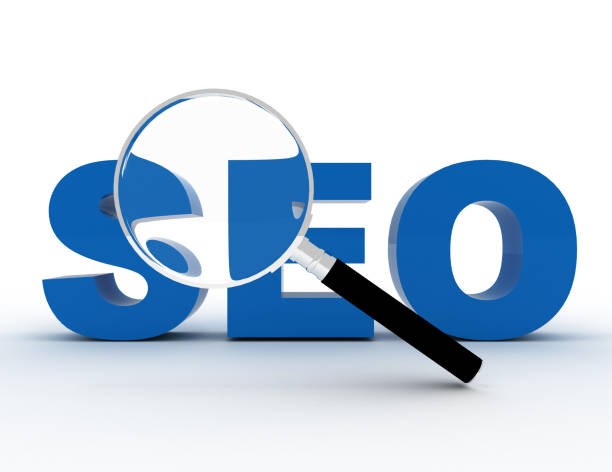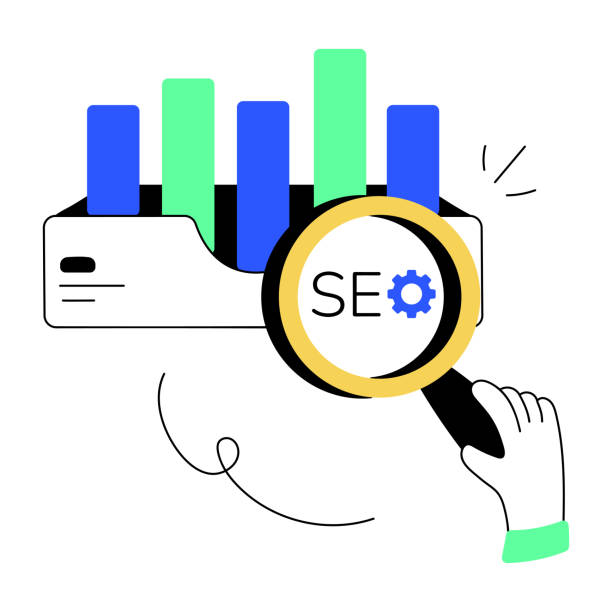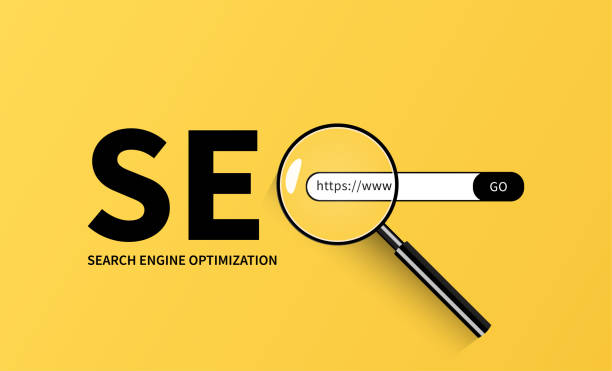Introduction to On-Page SEO and Its Importance

In today’s highly competitive world, #Digital_Marketing and #Online_Presence are vital for any business.
One of the most important pillars of this presence is Search Engine Optimization (SEO).
Among the various types of SEO, Internal SEO or On-Page SEO plays a fundamental and undeniable role.
This process includes all actions you directly perform on your website’s content and structure to achieve a better position in search results.
Optimizing a website internally helps search engines better understand your content and recognize its value.
This part of SEO, unlike Off-Page SEO which deals with backlinks and off-site activities, is completely under your control, and by focusing on details such as choosing appropriate keywords, optimizing titles and meta descriptions, content quality, and URL structure, you can significantly impact your site’s performance.
Being educational in this stage is essential for every webmaster, as it is the foundation of all subsequent efforts to be seen.
Without strong On-Page SEO, even the best content might never reach its target audience.
A precise understanding of the importance of on-page optimization allows you to provide the necessary infrastructure for attracting organic and high-quality traffic, ultimately achieving your business goals.
This specialized process requires attention to detail and a continuous approach.
Don’t have a corporate website yet and missing out on online opportunities? With professional corporate website design by Rasavveb,
✅ Double your business credibility
✅ Attract new customers
⚡ Free consultation for your corporate website!
Identifying Targeted Keywords for On-Page SEO
![]()
The first and perhaps most important step in implementing a successful On-Page SEO strategy is accurately identifying and selecting keywords.
Keywords should not only be relevant to your content’s topic but also cover users’ needs and questions.
A precise analysis of user behavior and the phrases they enter into search engines can help you find high-volume keywords with reasonable competition.
Various tools like Google Keyword Planner, Ahrefs, Semrush, and Moz Keyword Explorer can guide you in this process.
After identifying primary and secondary keywords, you should naturally and organically incorporate them into your content.
Overuse of keywords (keyword stuffing) will not only not help your On-Page SEO but can also lead to penalties by Google’s algorithms.
Remember that the main goal is to provide valuable and useful content for the user, and keywords are merely a tool to discover that content.
Choosing long-tail keywords, which are more specific and detailed, can drive more targeted traffic to your site, as these keywords usually indicate a clearer purchase intent or search.
A deep understanding of User Intent behind each keyword is the key to success in this stage.
Specialization in this section means the ability to differentiate informational keywords from commercial keywords.
Optimizing Title, Meta Descriptions, and URL Structure
![]()
After selecting keywords, it’s time to apply them to the vital elements of On-Page SEO: Title Tag, Meta Description, and URL structure.
These three elements not only help search engines understand your content but are also the first thing users see in search results.
The page title should be attractive, contain the main keyword, and express the page’s content.
The optimal length for a title is between 50 and 60 characters to be fully displayed in search results.
Meta descriptions, although not directly impacting ranking, play an important role in Click-Through Rate (CTR).
These descriptions should include keywords, persuasive text, and a Call to Action, and fully summarize the page’s content.
It is educational to know that the appropriate length for meta descriptions is about 150 to 160 characters.
A clarification on URL structure: a good URL should be short, readable, contain keywords, and reflect the content hierarchy on the site.
Avoiding complex characters and using hyphens (-) instead of underscores (_) to separate words are basic principles.
For example, url.com/on-page-seo-introduction is much better than url.com/page?id=123.
Adhering to these On-Page SEO tips helps search engines better understand your site’s structure, and users also have a better experience.
Did you know that changing a URL without proper redirects can lead to a loss of ranking and traffic? This thought-provoking content shows how important details are in On-Page SEO.
Below, you can see some key tips for this section:
| On-Page SEO Element | Importance | Key Optimization Tips |
|---|---|---|
| Title Tag | Very High | 50-60 characters, contains main keyword, attractive and relevant |
| Meta Description | High (Impact on CTR) | 150-160 characters, includes keywords, persuasive, and call to action |
| URL Structure | Medium to High | Short, readable, contains keywords, use hyphens |
Producing Quality Content and Optimizing It

The backbone of any On-Page SEO strategy is quality content.
Producing content that is valuable to users not only attracts them to your site but also sends positive signals to search engines.
Your content should be specialized, comprehensive, and responsive to user needs.
This includes articles, blog posts, product pages, videos, and infographics.
After content creation, optimizing it for On-Page SEO becomes crucial.
This optimization includes logically using Heading tags (H1, H2, H3, etc.) for structuring content, naturally placing keywords in the text, using optimized images with appropriate Alt Text, and internal and external linking.
A further explanation of Alt Text: This alternative text for images is not only understandable to search engines but also helps visually impaired users understand the image content.
This is an important aspect of accessibility and On-Page SEO.
Did you know that Google prefers long and comprehensive content? Provided its quality is maintained and redundancy is avoided.
Engaging content can increase user engagement rate and encourage them to stay longer on the page.
How much does losing business leads due to an unprofessional website cost you? With professional corporate website design by Rasavveb, solve this problem permanently!
✅ Increase credibility and trust of potential customers
✅ Attract new business leads more easily
⚡ Get a free consultation now!
Smart Use of Internal Linking
![]()
Internal Linking is one of the most powerful On-Page SEO tools that is often overlooked.
This process involves creating links from one page on your site to another page within the same site.
There are several reasons for its importance.
Firstly, it helps search engines better understand your site’s structure and discover new pages.
Secondly, it distributes Link Equity throughout your site, meaning highly authoritative pages can pass their authority to other pages.
Thirdly, it improves user experience, as it allows users to easily find related information and spend more time on your site.
For an effective internal linking strategy, you should use relevant and keyword-rich Anchor Texts.
Avoid over-linking from a single page and ensure that links lead to relevant and valuable pages.
A key tip is to link to pages you want to rank from more authoritative pages on your site.
This is a specialized method for strengthening On-Page SEO.
For example, if you have an article on “Principles of On-Page SEO” you can link from it to more detailed articles such as “Optimizing Title and Meta Descriptions” or “Keyword Research.”
This structured approach not only helps search engines better understand your site’s topics but is also engaging, as it moves the user along a logical path of information.
Optimizing Images and Multimedia Files

Images and other multimedia files such as videos and infographics play an important role in On-Page SEO and user experience.
Optimizing these elements can improve site loading speed, increase discoverability in image search, and make your content more engaging for users.
The first step in image optimization is to reduce their size without significant loss of quality.
Tools like TinyPNG or Compressor.io can guide you in this area.
Using next-generation image formats like WebP can also help reduce file size.
The most specialized part of image optimization is using appropriate Alt Text.
Alt Text, or alternative text, is a brief and accurate description of the image content that helps search engines and visually impaired users understand the image.
This text should contain relevant keywords, but avoid keyword stuffing.
The image file name should also be descriptive and contain keywords (example: on-page-seo-image.jpg).
For videos, in addition to optimizing the title and description, using a Transcript or subtitles can help search engines understand the video content and improve its On-Page SEO.
Another explanation is that incorporating videos and images into text content helps increase user Dwell Time on the page, which is a positive signal for ranking in Google, and analytically, we can say that this is an important indicator for the quality of engaging content.
Technical On-Page SEO Review of the Website

The technical part of On-Page SEO includes aspects directly related to your site’s coding and backend structure, and it directly impacts how your site is crawled and indexed by search engines.
Site speed is one of the most critical technical factors.
Both users and search engines prefer fast websites.
Tools like Google PageSpeed Insights can help you identify speed issues.
Code optimization, image compression, caching, and utilizing a CDN (Content Delivery Network) are solutions for increasing speed.
The good news is that Google continuously provides new tools to help webmasters in this area.
Responsiveness (Mobile-Friendliness) is also of high importance.
Given the increasing use of mobile phones to access the internet, having a responsive website that displays well on all devices is essential.
Google Mobile-Friendly Test can check this capability.
XML Sitemap and robots.txt file are other specialized components.
The sitemap helps search engines discover all important pages of your site, while robots.txt tells them which pages not to crawl.
Precise guidance on configuring these files is very important for On-Page SEO.
It is educational for every webmaster to know that errors like 404 pages or long redirect chains can also harm SEO and should be regularly checked and fixed.
Below is a table of the technical On-Page SEO checklist:
| Technical Aspect | Description | Tool/Method for Checking |
|---|---|---|
| Site Speed | Page loading time | Google PageSpeed Insights, GTmetrix |
| Responsiveness | Correct display on mobile and tablet | Google Mobile-Friendly Test |
| XML Sitemap | File to help crawlers | Google Search Console |
| Robots.txt | Control robot access to pages | Text editor, Google Search Console |
| 4xx/5xx Errors | Pages not found or server errors | Google Search Console, Audit tools |
User Experience (UX) and Its Connection to On-Page SEO

Google increasingly emphasizes the importance of User Experience (UX) in website ranking.
In fact, UX is an integral part of modern On-Page SEO.
An excellent user experience not only keeps users satisfied but also sends positive signals to search engines.
Factors such as Dwell Time, Bounce Rate, CTR, and the number of pages visited per session are all important metrics that Google uses to evaluate the quality of user experience and, consequently, your site’s On-Page SEO.
To improve UX, your site should have easy and intuitive navigation.
Menus should be clear, and users should be able to easily find what they are looking for.
The page Layout should be organized and readable, using sufficient white space, legible fonts, and short paragraphs.
Site loading speed, mentioned earlier, is also a critical factor in UX.
A slow site can drive users away.
It’s interesting to know that even your site’s visual design and color scheme can affect user experience! A precise analysis of user behavior on your site (using tools like Google Analytics and Hotjar) can identify UX weaknesses and help you improve your On-Page SEO.
A site with strong UX will naturally have a lower bounce rate and longer dwell time, all of which benefit your site’s ranking.
It is educational to always put yourself in the user’s shoes and see if your site meets their needs in the best possible way.
Losing potential customers due to an unprofessional website? Rasavveb is your answer! With our specialized corporate website design services:
✅ Enhance your business credibility and standing
✅ Experience attracting more targeted customers
⚡ Act now to get a free consultation!
Monitoring and Analyzing On-Page SEO Performance

After implementing your On-Page SEO strategies, your work is not done.
Continuous monitoring and analysis of performance are essential for identifying strengths and weaknesses and for subsequent optimizations.
Tools like Google Search Console and Google Analytics are among the most important tools for this purpose.
Google Search Console provides you with valuable information about how Google views your site, the keywords you rank for, crawl issues, security errors, and On-Page SEO improvements.
On the other hand, Google Analytics allows you to monitor site traffic, user behavior, traffic sources, conversion rates, and many other vital metrics.
A regular analysis of this data can show you which pages are performing well and which need further optimization.
For example, if a page has a high bounce rate, it might indicate low-quality content or poor UX.
If a page ranks for specific keywords but has low traffic, it might need optimization of its title and meta description.
It is advised to regularly review your On-Page SEO performance reports and make decisions based on the data.
This process is cyclical: implement, monitor, analyze, and re-optimize.
By following this cycle, you can ensure that your On-Page SEO efforts are continuously moving towards improvement and increased targeted traffic.
The good news is that many of these tools are free and only require learning and time for effective use.
Avoiding Common On-Page SEO Mistakes

Despite the high importance of On-Page SEO, many webmasters and even professionals make common mistakes that can render their efforts ineffective.
Understanding these errors and avoiding them is a crucial part of a successful On-Page SEO strategy.
One of the most common mistakes is Keyword Stuffing.
In the past, some believed that by filling the text with keywords, they could achieve a higher ranking, but today, this not only doesn’t help your ranking but can also lead to penalties by Google.
Your content should be natural and written for the user.
Another mistake is neglecting site speed and lack of responsiveness.
As previously mentioned, these factors directly impact user experience and ranking.
Also, failing to optimize images (high volume, inappropriate Alt Text) and weak or insufficient internal linking are common errors.
A further explanation regarding common errors: Duplicate Content within the site or from other sites can harm your On-Page SEO.
Ensure that each page has unique content.
Ignoring technical settings such as the robots.txt file and XML sitemap can also prevent search engines from correctly crawling the site.
It is educational to know that by regularly reviewing the site and using monitoring tools, many of these errors can be identified and corrected before they cause serious damage.
Specializing in On-Page SEO means not only knowing the correct methods but also being aware of common risks and mistakes.
Frequently Asked Questions
| Question | Answer |
|---|---|
| What is On-page SEO? | On-page SEO refers to the set of actions performed within your website to improve its ranking in search engine results. This includes optimizing content, site structure, and HTML code. |
| Why is On-page SEO important? | On-page SEO helps search engines understand your page’s content and determine if your content is relevant to searchers. It is the foundation of any successful SEO strategy. |
| What are the key elements of On-page SEO? | Title Tag, Meta Description, keyword usage, image optimization, heading structure (H1, H2, …), internal linking, and content quality are key elements. |
| How to optimize the Title Tag? | The page title should include the main keyword, be attractive and compelling for clicks, and have a length of 50 to 60 characters (or appropriate pixels) to be fully displayed in search results. |
| What is the role of Meta Description in On-page SEO? | The meta description is a summary of the page’s content displayed below the title in search results. Although it does not directly affect ranking, it helps SEO by increasing the Click-Through Rate (CTR). |
| What is the importance of using heading structure (H1, H2, H3) in On-page SEO? | Headings structure the page content and make it easier to read. H1 is usually the main title of the page and should include the keyword. H2 and H3 for organizing subsections and help search engines understand the content hierarchy. |
| How to effectively use keywords in content? | Keywords should be used naturally and logically throughout the content, including the introduction, body, and conclusion. Avoid keyword stuffing. |
| What steps are involved in optimizing images for On-page SEO? | It involves compressing images to reduce size, using descriptive file names, adding appropriate alternative text (Alt Text), and optimizing the image title and description. Alt Text is crucial for accessibility and helping search engines understand image content. |
| What is Internal Linking and what are its benefits? | Internal linking means creating links from one page on your website to another page on the same website. This helps users easily navigate your site, distributes page authority throughout the site, and helps search engines better understand your site’s structure. |
| What is the importance of content quality in On-page SEO? | High-quality, accurate, comprehensive, and valuable content for users, is the cornerstone of On-page SEO. Search engines prefer content that meets user needs. Quality content leads to longer Dwell Time and a lower Bounce Rate, which are positive SEO signals. |
And other advertising services from Rasaweb Advertising Agency
Smart Marketing Automation: A dedicated service for growth in website traffic based on marketing automation.
Smart SEO: An effective tool for online growth through Google Ads management.
Smart Sales Automation: Professional optimization to increase click-through rates using key page optimization.
Smart Customer Journey Map: Designed for businesses looking to analyze customer behavior through attractive UI design.
Smart Content Strategy: Designed for businesses looking for online growth through attractive UI design.
And over hundreds of other services in the field of internet advertising, advertising consultation, and organizational solutions
Internet Advertising | Advertising Strategy | Advertorials
Sources
Comprehensive Guide to Internal SEO
On-Page SEO and Ranking Improvement
On-Page SEO Tutorial
On-Page SEO Guide for Targeted Traffic
💭 Ready to revolutionize your business in the digital world? Rasaweb Afarin Digital Marketing Agency offers comprehensive solutions, from e-commerce website design to search engine optimization and social media management, paving your way to online success. Contact us today and transform the future of your business.
📍 Tehran, Mirdamad Street, next to Bank Markazi, Southern Kazeroon Alley, Ramin Alley, No. 6



